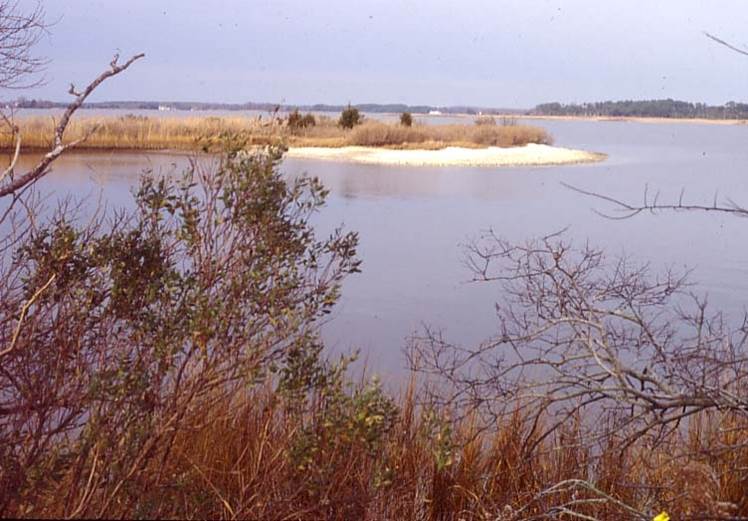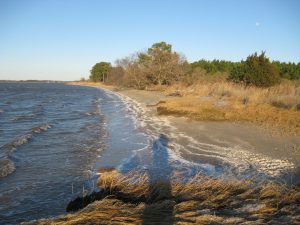(Originally published in the Spring 2001 issue of American Archaeology and updated November 2024)
The Chesapeake Bay, with its moderate weather and abundant resources, was a fertile and navigable home for Native Americans. Plus, Maryland’s Eastern Shore had the advantage of being relatively inaccessible to foes across the bay.
The Conservancy’s most recent preserve, Maddox Island on the Eastern Shore, may answer questions about the Late Woodland and early historic periods in the region. Overlooking the placid Chesapeake Bay, Maddox Island may be one of the most scenic landscapes in North America. The 23-acre site represents roughly half of a historic homestead known since 1750 as the Maddox Island Farm. The centerpiece of the site is a vast shell midden covering approximately half the property. During a 1996 survey for the Maryland Division of Historical and Cultural Affairs, archaeologist Darrin Lowery recovered numerous pottery sherds, stone tools and points, and shells on the fertile fields at the mouth of the Manokin River. Maddox Island is among the most extensive and well-stratified sites along the 115-mile-long Eastern Shore.
Other cultural resources represented at the site include a brick limekiln ruin filled with burnt oyster shell. The kiln is likely related to a group of pilings along the shoreline, perhaps the remains of a maritime business venture that went bankrupt in the 19th century.
In the fall of 2000, in a meeting with landowner Richard Warbasse, the Conservancy’s Mark Michel and Rob Crisell discussed the idea of protecting the property as an archaeological preserve. Unfortunately, one could only guess the condition of subsurface features since no formal excavations had taken place. Warbasse generously agreed to allow the Conservancy two months to test the site.
Maryland State Archaeologist Richard Hughes recommended Towson University archaeologist Bob Wall for the dig. Wall had worked most recently on the Barton property in Cumberland, Maryland, assisting the Conservancy in its efforts to permanently preserve this important site (see “Prehistory at Maryland’s Crossroads,” Fall 2000). In December, Wall and his team dug a series of test pits in the field, encountering ancient shells nearly everywhere they looked. One unit revealed intact shells at the bottom of the midden and distinct features below that, including two trash pits with shells and animal bones. Wall notes that Lowery and others have identified artifacts that indicate early occupation at the site, as long ago as 6000 B.C.
“I’ve run into enough of these sites to know that you usually don’t get very good preservation in them,” says Wall, who hopes to return to the property in the future.
He speculates that the site may have been a small village. “I think there is tremendous potential to find community patterns on the site,” Wall says. “From the condition of the pit features, there is a good possibility that you could find some structural evidence along with all the other kinds of evidence you might get, such as hearths and storage pits.”
Armed with the results of the brief excavation, the Conservancy and Warbasse agreed to proceed with the purchase. Warbasse and his partners also donated a conservation easement to the Conservancy, which protects the adjacent 25-acre field and more than 250 acres of surrounding wetlands.
The Conservancy’s 200th site promises to be not only one of the most interesting preserves, but also one of the most beautiful. From the earliest American Indian settlers to the English in the 1600s, people have been coming to Maddox Island for hundreds of years. With the permanent protection of the site, the Conservancy will make sure the site remains intact and accessible to people indefinitely.





